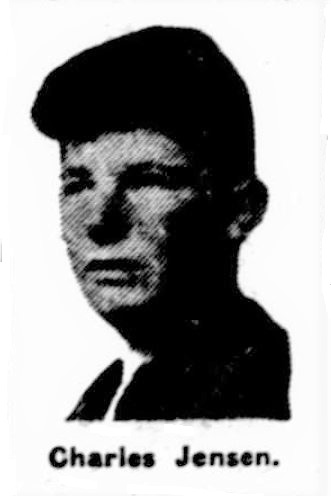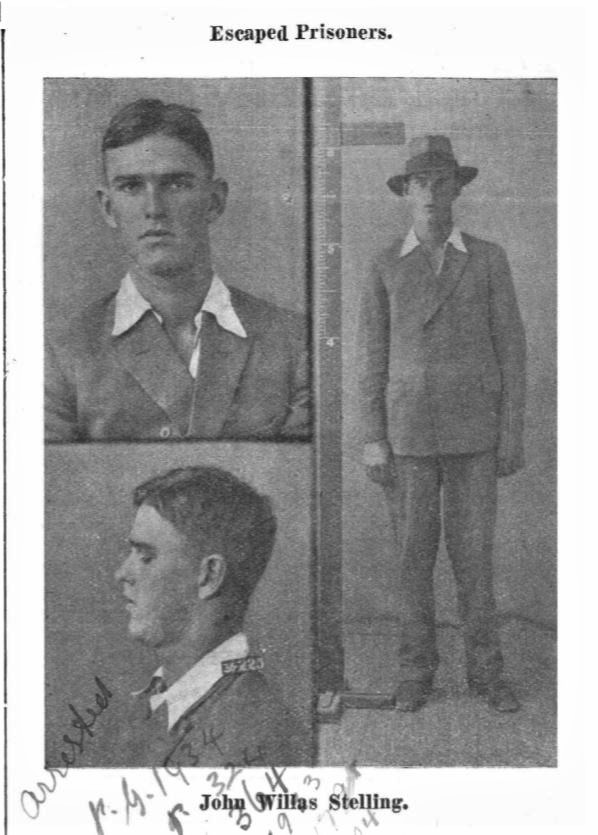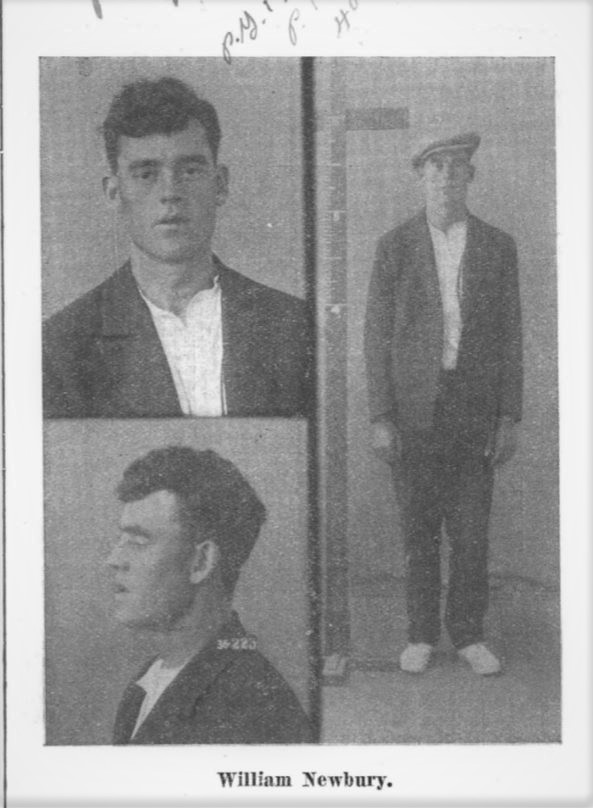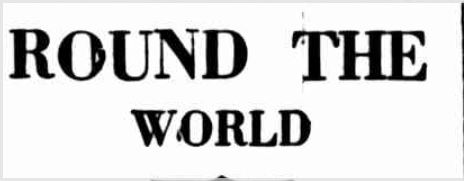The Reverse Escape
- On : 7 September, 2018
- By : Boggo Road Gaol
- Category : Stories
- View : 1880
The Reverse Escape – John Willas Stelling and William Newberry
Three young men; each of them out of work and down on their luck broached the big lights of Brisbane for a change in their fortunes. Three days and a short voyage later their trip to Brisbane would end in salvation for one and for the other two a twelve month stay in a hell hole.
John Stelling (Description at discharge)
Native Place: South Australia
Age: 25
Height: 6 feet (183cm)
Build: Proportionate
Complexion: Fresh
Hair: Fair
Eyes: Blue
Weight: 11 stone 8 oz (73.5kg)
Remarks: Tattoo of woman on back of left forearm, sailing ship and anchor and “Homeward Bound” on front. And “Laurel” on right forearm. Four small moles on back.
William Newberry (Description at discharge)
Age: 23
Height: 5 feet 10 inches (178cm)
Build: Proportionate
Complexion: Fresh
Hair: Dark Brown
Eyes: Light Blue
Weight: 11 stone (70kg)
Remarks: Top of little finger left hand squashed; large scar inside left thigh.
The Crime

William Newberry, a ships firemen and John Willas Stelling, a seaman, were known to each other. Both having come from South Australia, they had been working on coastal and overseas shipping. Recently having been paid off from their last overseas voyage they had spent their money quenching their thirst from months at sea. All well and good, but now they found themselves broke and in need of work. No problem! They would just get another job and earn themselves more. Of course, there is an economic downfall, and no one is hiring.
Sometime on the road from the Port of Melbourne to Brisbane they came across young Charles Henry Jensen, who had left Melbourne and decided to seek his fortune elsewhere. The eighteen-year-old labourer had even less prospects than Newberry and Stelling, with no family in Australia he really was in a dire situation. Whether they took pity on him or whether he just decided to tag along is not known.
The trio arrived in Brisbane on the 25th of October, trying their luck on the coastal ships at the Hamilton reach they came up empty. It was clear they had to come up with another plan. Meanwhile the crew of a local ship had taken pity on them and plied them with a bit of drink and a friendly game of cards.
In the wee hours of the 26th, still drunk from their outing with the crew. The wily Stelling and Newberry spied the Helene II, the vessel belonging to Colonel Frederick Annand being loaded with provisions for its master and his friends. A little further out the Mako owned by Dr Val McDowell. Spotting the dinghy belonging to George Robinson, the three men pushed it into the water, making for the Helene 2 a motor launch with the plan of transferring its provisions to the Mako, a much larger and sea going motor launch.
Shipwrecked
They broke a skylight gaining access to the Mako but were unable to start her. Transferring back to the Helene II, they then towed her down river. Jensen acting as pilot, the voyage was going swimmingly until in the early morning light, a large ship appeared on their bow. Having no knowledge of the river they sailed the wrong side of the beacons. The wash of the ship running them aground on Wreck Island (later known as Bishop Island and now part of the Port of Brisbane)
Once ashore, the men decided it would be best to eat and gather their strength. There were ample provisions and a bottle of Brandy aboard the Doctor’s launch. They found a hurricane lamp to use as a stove, but it toppled over setting fire to the Helene II. The two experienced seamen quickly quenched the fire but not before terrible damage had been done. They were forced to eat their meal cold and raw. No doubt adding to their misery.
Daylight saw the three men, insect bitten and musing their bad luck. Of course, Colonel Annand, who had planned a voyage that day had noticed his vessel missing. Dr McDowell too, his motor launch. Report was made to the Water Police, where immediate search was launched. Colonel Annand even had hired an aeroplane for a bird’s eye view. It was Colonel Annand that had first spotted the vessels at the mouth of the river.
Capture
The missing vessels were found ran aground on Wreck Island, abandoned. Jensen, Newberry and Stelling having seen the water police coming, scattered amongst the mangroves in a poor attempt to hide. Taken into custody, they were taken to the lockup and set to appear the next day before Police Magistrate Hishon.
Pleading guilty, the three men were convicted of the theft and damage of the three vessels. Jensen having begged that his behaviour was only due to his being drunk and that he would not have ordinarily undertaken such a foolish venture. The magistrate seemingly took pity of Jensen, releasing him to the care of the Salvation Army with a fifteen-pound surety that he would not appear again within twelve months. Ensign Birt of the Salvation Army undertook to locate his parents who were holidaying in Norway.
Newberry and Stelling were not so lucky. Being found guilty on each of the five charges, they were sentenced to two months with hard labour on each charge, to be served cumulatively.
To St Helena
At this time in Brisbane, the majority of male prisoners were not held at Boggo Road Gaol. Only those with long sentences or those under the sentence of death were held there. Female prisoners having their own division (Number two division and the only remaining portion of Boggo Road Gaol). The short-term men were transported to St Helena Island, in Moreton bay for the duration of their sentence. This prison was more like a prison farm, with more freedom and a less rigid system of management than Boggo Road.
Newberry and Stelling were transported by the government vessel Otter to begin their sentence in November 1929.
Escape!
Tired after just a few short months imprisoned at St Helena, a prison that has a reputation for its brutal treatment of prisoners. Newberry and Stelling decided on the 15th of March that it would be their last day on the Island. Somewhere between 6:30 and 8pm they made their escape. Knocking the padlock off the boathouse storing the rowboats belonging to the government, they eased a boat into the water and paddled silently across the bay.
Their absence was noted around 8pm and the alarm was sounded. Police were contacted, and all attempt was made to locate them in the darkness. Ever so silently they paddled to shore, eventually landing at Lota.
The next morning, the missing boat was located at the mouth of Lota Creek. Newberry and Stelling were no where to be found. It wasn’t until later in the morning that a report of a missing car from Cleveland belonging to Dr. Arthur Howard came in that police had even a clue where to start looking.
The Stolen Car
The distinctive single seater Studebaker Commander straight eight with red crosses on the number plates was eventually located in Guy street at Warwick, just a few miles shy of the border. It was soon discovered that the car had run out of fuel, and rather than risk refuelling, the prisoners simply abandoned it. It was discovered by Warwick Police and returned to the owner without damage.
Newberry Captured
William Newberry had been on the run for three and a half months, when with ten other young men were arrested for malicious damage in Clovelly, a suburb of Sydney, New South Wales. The men had done serious damage to a cottage to the value of fifty pounds as part of a communist action. Newberry of course was using an alias. But it was quickly discovered his true identity. He was sentenced to six months imprisonment in Darlinghurst prison for his role in the communist action. He was then remanded back to Brisbane to face punishment for the escape from St Helena.
Returned to Brisbane he faced sentencing before Police Magistrate Leahy, Newberry was sentenced to an additional two months and fourteen days for the escape from St Helena, in addition to serving the remainder of his sentence. All to be served with hard labour. This time, his sentence would be served in the notorious Boggo Road Gaol.
Surrender
Thursday 27th of September was like any other day at Boggo Road. It started and ended with the ringing of the bell to signal to the prisoners where they were meant to be and when. This day however still had a little more in store for the Superintendent Whitney. Shortly before 8pm, Superintendent Whitney was informed that a man wished to see him at the 
“You got away from St Helena four years ago,” said the Superintendent. “This is a strange place for you to visit!” “Yes, I am Stelling,” replied the escapee “I want to get this business over; can you tell me what to do?” Naturally Mr Whitney took the only course available to him and communicated with the police, who shared his surprise at the reappearance of Stelling.
Twice around the world
From the pages of the Courier Mail, 29th of September 1934.
According to Stelling’s story, after rowing ashore at Lota they then separated, and he had not since heard what had become of Newberry. Prison officials were able to inform, him, however, that his companion had been arrested some time ago.
An engineer by trade, Stelling was anxious to obtain a position on an overseas vessel, and, with that end in view, he set out for Sydney. Without money he was faced with the prospect of covering the journey on foot, but he was able to make his task easier by hailing passing vehicles.
Fortune favoured him when he arrived in Sydney, and within a few days he was on the high seas, booked as an engine-room hand in a cargo vessel. In England he was able to obtain only irregular employment, and eventually found himself once more afloat — this time bound for America.
Stelling was reticent as to the time he spent in the different countries and the names of the vessels in which he travelled, but last year he returned to England. Throughout his wanderings, he declared, he was unhappy in the knowledge that he was a fugitive from justice, and his varying fortunes convinced him that he would have been wiser to have served the remaining four months of his sentence.
Though he was able to obtain regular employment, his return to England did nothing to improve his peace of mind, and he determined to come back to Australia, disclose his identity, and serve the remainder of his term. “I am anxious,” he said yesterday, “to get this wretched business over, and start again with a clean slate.”
To accomplish his purpose, he obtained a berth in an Australian-bound steamer and reached Melbourne early this week. He arrived in Brisbane by train on Thursday afternoon, and four hours later was lodged once more in prison. That he had not been driven to his decision by dire necessity was evidenced by the fact that, when he called on Mr. Whitney, Stelling was well dressed and had money in his pockets.
In the Police Court yesterday Stelling was sentenced to serve a month’s imprisonment, in addition to his four months’ unexpired term. Last night he told the prison authorities that he had been treated more leniently than he had expected, and that his mental anguish during the last four years had more than off-set the success of his bid for liberty.
So, there you have it, the reverse escape that found both parties locked up in the notorious HM Prison Brisbane later known as Boggo Road Gaol, twice. By the time Stelling had turned himself in, St Helena prison had been abandoned, not that they would have risked him escaping to sea one more time, certainly not! What happens to these wily characters is not known, one thing is for sure this is the last time they are seen at the gates of Boggo Road Gaol.
This Sunday come behind the giant red brick walls and heavy steel gates and hear about some of the desperate prisoners that tried to escape Boggo Road Gaol and some of the few that succeeded. You can book your tickets here
This article was contributed by Research Coordinator Sue Olsen as part of the ongoing research program for Boggo Road Gaol Pty Ltd. The aim of the program is to bring to light and share articles relating to Boggo Road for the purposes of review and study. Do you have a story to share or something you would like us to know about? You can contact the research team here







